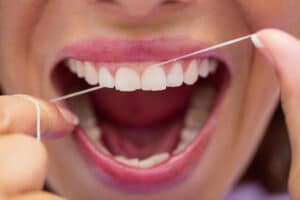Flossing is more than just moving a piece of string between your teeth. It’s about doing it right to reap the full benefits. Proper flossing plays a crucial role in preventing gum disease and cavities, ensuring your smile remains bright and your breath stays fresh. Discover the steps and techniques on how to floss correctly to ensure that you not only remove those stubborn food particles but also promote optimal gum health.
Step-by-Step Guide to Correct Flossing
Proper Floss Length and Technique

- Begin with an 18-inch piece of dental floss. This might seem excessive, but it ensures you have a fresh section for each tooth.
- Wind the floss around your middle fingers, leaving about two inches of floss to work with.
- Use your index fingers and thumbs to guide the floss gently between your teeth. Avoid snapping it, as it could harm your gums.
Holding and Maneuvering the Floss
- Form a “C” shape around each tooth with the floss, making sure to reach below the gumline.
- Glide the floss up and down against the side of each tooth, gently scraping away plaque and debris.
- Repeat the process for every tooth, including the back molars, and don’t forget the often-neglected farthest molars.
Addressing Common Mistakes and Misconceptions
- Rushing Through the Process: Take your time. It’s not a race. Rushing can lead to incomplete cleaning.
- Skipping Back Teeth: Those back molars need love too. Make sure your floss reaches every nook and cranny.
- Being Too Rough: Flossing should be gentle. Avoid aggressive movements to prevent gum irritation.
Choosing the Right Floss for You
With an array of options available, finding the perfect floss can enhance your overall experience and effectiveness. The factors to consider when selecting dental floss include:
- Dental Condition Matters: If you have dental work like braces or bridges, thin, waxed floss or specialized threaders may be your best bet. Individuals with wider gaps between teeth may find dental tape more effective in capturing debris.
- Personal Preferences Count:
- Flavor and Texture: Some floss comes in various flavors, from mint to fruit. Experiment to find a flavor that makes flossing a more enjoyable experience. Likewise, consider the texture that feels most comfortable for you.
- Ease of Use: Floss picks can be convenient for those who struggle with traditional floss. They are pre-threaded and often come with a small handle for easier maneuvering.
- Accessibility and Ease of Use: Consider your daily routine and lifestyle. If you’re always on the go, floss picks or disposable flossers might be more practical. Water flossers can be a great alternative for those who prefer a gadget-driven approach.
Remember, there’s no one-size-fits-all solution when it comes to flossing. Experiment with different types until you find what works best for you. Ultimately, the key is consistency and finding a flossing routine that seamlessly integrates into your daily life.
Benefits of Knowing How to Floss Correctly
Knowing how to floss correctly has numerous benefits. It’s a proactive step towards maintaining a healthy and radiant smile. Here’s why it matters:
Prevention of Gum Disease and Cavities:
Flossing helps remove plaque from areas that your toothbrush might miss, especially between teeth and along the gumline. By preventing the buildup of plaque, you significantly reduce the risk of gingivitis and more severe gum diseases.
Contribution to Fresh Breath and Overall Oral Health
Flossing eliminates trapped food particles and bacteria that contribute to bad breath, leaving your mouth feeling fresh. It complements brushing by reaching areas your toothbrush can’t, ensuring a more thorough clean.
Potential Cost Savings on Dental Treatments
Regular flossing is a form of preventive care that can save you from costly dental treatments down the road. By tackling plaque and preventing cavities, you reduce the likelihood of needing fillings or more extensive dental work.
Troubleshooting Common Flossing Challenges
Part of knowing how to floss correctly is overcoming some common challenges with flossing. This will not only enhance the effectiveness of your routine but also make it a more seamless part of your daily life.
- Dealing with Tight Spaces Between Teeth: Opt for thinner floss or dental tape to navigate tight spaces more easily. Be patient and gentle when maneuvering through narrow gaps. Jerky movements can lead to floss breakage or injury to your gums.
- Overcoming Sensitivity Issues During Flossing: Waxed floss tends to glide more smoothly between teeth and may be gentler on sensitive gums. If regular floss feels harsh, consider running it between your fingers to soften it slightly before use.
Tips for Making Flossing a Habit in Your Daily Routine
- Set Reminders: Use phone alarms or tie flossing to an existing habit, like brushing your teeth, to make it a consistent part of your routine.
- Reward Yourself: Treat yourself after flossing as a positive reinforcement strategy.
Remember, overcoming these challenges is a natural part of the learning curve. As you persist and adapt, knowing how to floss correctly will become second nature, contributing to a healthier smile and improved oral well-being.
Expert Tips and Advice
- Regular Dental Check-ups: Dentists recommend regular check-ups to assess your oral health and provide personalized advice on flossing techniques tailored to your dental condition.
- Professional Demonstrations: Ask your dentist or dental hygienist for a demonstration of proper flossing technique during your appointments.
- Mouthwash: Incorporating an antiseptic or fluoride mouthwash into your routine can complement flossing by reaching areas your toothbrush can’t.
- Interdental Brushes: These small brushes can be useful, especially if you have larger gaps between your teeth or dental work.
Frequently Asked Questions (FAQs)
Navigating the world of correct flossing can bring about various questions and concerns. Addressing some of the common queries can provide clarity and guide you towards a more confident and effective flossing routine.
- How often should I floss? Ideally, floss once a day to ensure consistent plaque removal and maintain optimal gum health.
- Is there a specific time of day to floss? Flossing can be done at any time that fits your routine, but many find it effective to floss before brushing their teeth.
- Can I reuse dental floss? Dental floss is designed for single use. Reusing floss can reintroduce bacteria and reduce its effectiveness.
- Is it normal for my gums to bleed when I floss? Occasional bleeding might occur, especially if you’re just starting or haven’t flossed consistently. However, persistent bleeding could indicate a problem, and it’s advisable to consult your dentist.
- Do I still need to floss if I use a water flosser? While water flossers can be effective, they might not entirely replace traditional flossing. Consider using both for comprehensive oral care.
- How can I make flossing a habit? Set reminders, incorporate them into an existing routine, and reward yourself for turning flossing into a consistent habit.
- Can children floss, and when should they start? Children can start flossing when their teeth are close enough to touch, usually around 2–3 years old. It’s recommended to assist them until they develop the dexterity to do it themselves.
Elevate Your Smile Health with Advanced Emerald Dentistry
At Advanced Emerald Dentistry in Pierce County, WA, we prioritize your family’s oral health, offering a comprehensive range of services, from preventive care to emergency treatments. Our team of highly trained and experienced dentists is committed to delivering exceptional care in a warm and caring environment.
Why Choose Us?
- Gentle and Caring Approach
- Highest Quality Dental Services
- Convenient Locations in Puyallup and Graham
Take the next step towards healthier smiles. Contact us now to schedule your appointment and experience dentistry that goes beyond expectations.


